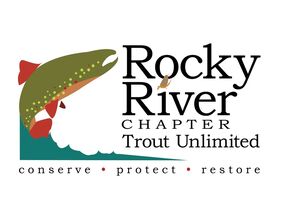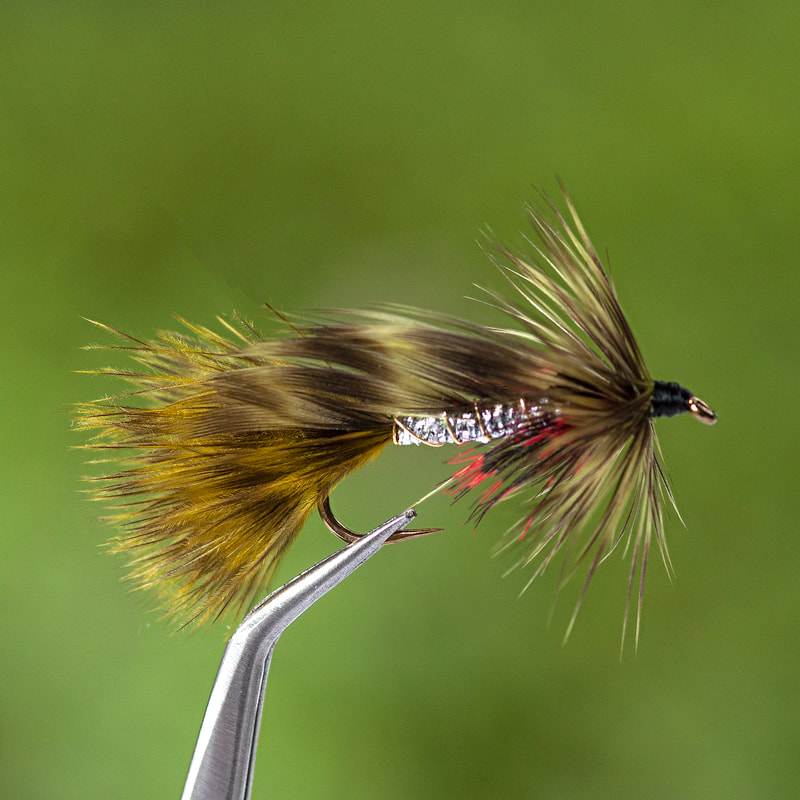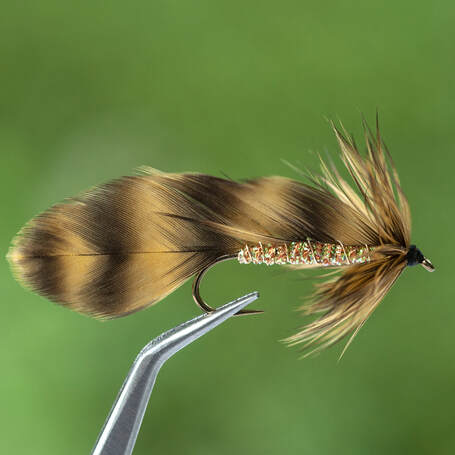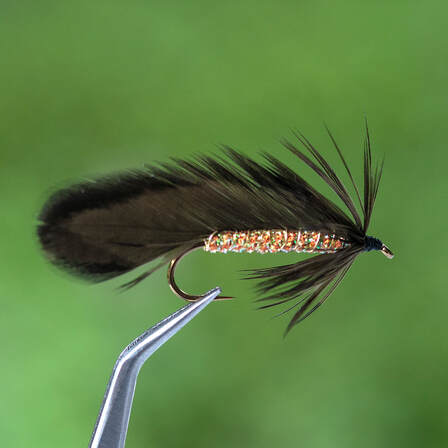Fly of the Month 12.16 - Matuka Streamer
When tying a stream, most fly patterns are designed with “sings” tied just behind the head with or without an eye. The Matuka fly pattern is uniquely tied with the feather attached at intervals across the top of the hook shank. This method produces a very durable fly pattern.
“The Matuka is a streamer pattern that most believe hails from New Zealand, but others say its origins are US based. Trout really don’t care. The unique method of attaching the wing to the body prevents the wing from becoming fouled on the hook point and makes for a very fishy silhouette. My tiers prefer hen feathers, (saddles or capes, depending on the fly size) for the wing on this pattern as their natural webbiness allows the wing to meld together across the tinsel rib. Rooster feathers will work also but result in a much more transparent wing that spreads across the top of the body and loses some of the profile. You can add a cone or bead to this pattern or simply tie it as it is presented here. The overall shape of the fly is reminiscent of a variety of common baitfish and matches sculpins particularly well.” - Posted on July 19, 2015 by Don Kirk
There are not many colors or variations of the Matuka found among the thousands of stream fly patterns. The slight difficulty of tying and the popularity of the many other streamer series has placed the Matuka on a back burner to be discovered and exploited in the future.
When tying a stream, most fly patterns are designed with “sings” tied just behind the head with or without an eye. The Matuka fly pattern is uniquely tied with the feather attached at intervals across the top of the hook shank. This method produces a very durable fly pattern.
“The Matuka is a streamer pattern that most believe hails from New Zealand, but others say its origins are US based. Trout really don’t care. The unique method of attaching the wing to the body prevents the wing from becoming fouled on the hook point and makes for a very fishy silhouette. My tiers prefer hen feathers, (saddles or capes, depending on the fly size) for the wing on this pattern as their natural webbiness allows the wing to meld together across the tinsel rib. Rooster feathers will work also but result in a much more transparent wing that spreads across the top of the body and loses some of the profile. You can add a cone or bead to this pattern or simply tie it as it is presented here. The overall shape of the fly is reminiscent of a variety of common baitfish and matches sculpins particularly well.” - Posted on July 19, 2015 by Don Kirk
There are not many colors or variations of the Matuka found among the thousands of stream fly patterns. The slight difficulty of tying and the popularity of the many other streamer series has placed the Matuka on a back burner to be discovered and exploited in the future.
Fly of the Month 07.20
A unique streamer style from the land of the Kiwi is the Matuka. For durability and to create a firm, wide looking girth on a streamer, the wing feather is partly striped as a half-feather and attached directly to the hook shank (quill against shank) with a wire or thread ribbing. The Matuka began as a lake fly in New Zealand in 1883. It soon became well known and used as a western streamer in the United States.
While tying a Matuka fly pattern, the idea expanding on the technique of attaching the “fish fin” to the hook shank lead to two new fly patterns that Tom and I are introducing for the first time in this article:
Arrow
Darter
The muddler minnow is a well-known bottom bouncing fly pattern that basically represent a sculpin or other bottom feeding forage fish which trout readily eat given the opportunity. However, many of the Southeastern and in particular the Southern Appalachian streams have a bottom dwelling forage fish, the darter. Darters come in a variety of brightly mixed colors, especially the males during the spawn. Bright green, bright orange, bright yellow and bright red in particular provide a mosaic of colors on the darter’s fins depending on the species. By using bantam sized feather on a given color such as white or one of the aforementioned colors and using a marker pen to add additional color, it is simple to create darter fins that are fairly realistic.
The new twist to the Darter fly pattern is to tie in the dorsal fin along with two pectoral fins on each side of the fly pattern using the Matuka technique. Thus, the Darter has three colored feathers attached in Matuka style with the pectoral fins pointing slightly downward, forming equally spaced fins in three directions. For the Darter, the dorsal and pectoral fins are brief rather than extending beyond the tail giving a realistic fin appearance. The aft portion of the hook shank is tied with a marabou tail for motion, a tinsel body for flash and a palmered overbody for color and motion.
The Arrow fly pattern is tied in the same manner, but all three feathers are attached and allowed to extend beyond the tail, providing a general attractor streamer fly pattern that looks much like the three feather on an arrow. The body is a simple tinsel wrap for flash.
For both fly patterns, the feathers used should be proportionally tall to keep the overall streamer appearing somewhat stubby with flaring fins. The fly pattern will be a bit more wind resistant and present some difficulty in a long cast. Otherwise, the fly patterns will be fishy underwater where it counts!
Matuka
Arrow
Darter
Fly of the Month 07.20
Tom Adams and Alen Baker
A unique streamer style from the land of the Kiwi is the Matuka. For durability and to create a firm, wide looking girth on a streamer, the wing feather is partly striped as a half-feather and attached directly to the hook shank (quill against shank) with a wire or thread ribbing. The Matuka began as a lake fly in New Zealand in 1883. It soon became well known and used as a western streamer in the United States.
While tying a Matuka fly pattern, the idea expanding on the technique of attaching the “fish fin” to the hook shank lead to two new fly patterns that Tom and I are introducing for the first time in this article:
Arrow
Darter
The muddler minnow is a well-known bottom bouncing fly pattern that basically represent a sculpin or other bottom feeding forage fish which trout readily eat given the opportunity. However, many of the Southeastern and in particular the Southern Appalachian streams have a bottom dwelling forage fish, the darter. Darters come in a variety of brightly mixed colors, especially the males during the spawn. Bright green, bright orange, bright yellow and bright red in particular provide a mosaic of colors on the darter’s fins depending on the species. By using bantam sized feather on a given color such as white or one of the aforementioned colors and using a marker pen to add additional color, it is simple to create darter fins that are fairly realistic.
The new twist to the Darter fly pattern is to tie in the dorsal fin along with two pectoral fins on each side of the fly pattern using the Matuka technique. Thus, the Darter has three colored feathers attached in Matuka style with the pectoral fins pointing slightly downward, forming equally spaced fins in three directions. For the Darter, the dorsal and pectoral fins are brief rather than extending beyond the tail giving a realistic fin appearance. The aft portion of the hook shank is tied with a marabou tail for motion, a tinsel body for flash and a palmered overbody for color and motion.
The Arrow fly pattern is tied in the same manner, but all three feathers are attached and allowed to extend beyond the tail, providing a general attractor streamer fly pattern that looks much like the three feather on an arrow. The body is a simple tinsel wrap for flash.
For both fly patterns, the feathers used should be proportionally tall to keep the overall streamer appearing somewhat stubby with flaring fins. The fly pattern will be a bit more wind resistant and present some difficulty in a long cast. Otherwise, the fly patterns will be fishy underwater where it counts!
Matuka
Arrow
Darter
Fly of the Month 07.20
Tom Adams and Alen Baker



